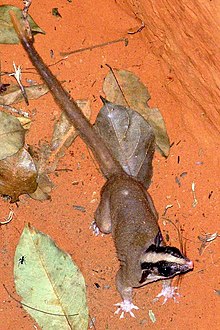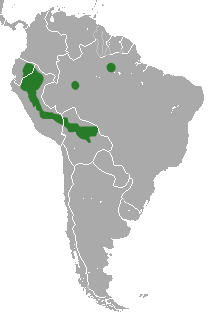Bushy-tailed opossum
| Bushy-tailed opossum | |
|---|---|

| |
| Scientific classification | |
| Domain: | Eukaryota |
| Kingdom: | Animalia |
| Phylum: | Chordata |
| Class: | Mammalia |
| Infraclass: | Marsupialia |
| Order: | Didelphimorphia |
| Family: | Didelphidae |
| Subfamily: | Glironiinae Voss & Jansa, 2009[3] |
| Genus: | Glironia Thomas, 1912[2] |
| Species: | G. venusta
|
| Binomial name | |
| Glironia venusta | |

| |
| Range of the bushy-tailed opossum | |
| Synonyms[5] | |
|
G. aequetorialis H. E. Anthony, 1926[4] | |
The bushy-tailed opossum (Glironia venusta) is an
Taxonomy and etymology
The bushy-tailed opossum is the sole member of Glironia, and is placed in the family
The
| |||||||||||||||||||||||||||||||||||||
The
Description
The bushy-tailed opossum is a medium-sized opossum characterized by a large, oval, dark ears, fawn to cinnamon coat with a buff to gray underside, grayish limbs, and, as its name suggests, a furry tail. The face is marked by two bold, dark stripes extending from either side of the nose through the eyes to the back of the ears. These stripes are separated by a thinner grayish white band, that runs from the midline of the nose to the nape of the neck. The texture of hairs ranges from soft to woolly; the hairs on the back measure 7 to 8 millimetres (0.28 to 0.31 in).[6][8] Five nipples can be seen on the abdomen; it lacks a marsupium.[5] The tail, 19.5 to 22.5 centimetres (7.7 to 8.9 in) long, becomes darker and less bushy towards the tip. Basically the same in color as the coat, the tip may be completely white or have diffuse white hairs.[6]
The head-and-body length is typically between 16 and 20.5 centimetres (6.3 and 8.1 in), the hindfeet measure 2.7 to 3.1 centimetres (1.1 to 1.2 in) and the ears are 2.2 to 2.5 centimetres (0.87 to 0.98 in) long.
Ecology and behavior
Little is known of the behavior of the bushy-tailed opossum. Less than 25 specimens are known.
Distribution and status
The bushy-tailed opossum has been captured from heavy, humid,
References
- ^ . Retrieved 11 November 2021.
- ^ .
- ^ S2CID 85017821.
- ^ hdl:2246/4158.
- ^ ISBN 978-0-226-28242-8.
- ^ JSTOR 3504067. Archived from the original(PDF) on 2015-04-04. Retrieved 2016-05-31.
- S2CID 17393886.
- ISBN 978-0-226-19542-1.
- ^ S2CID 86445704.
- ^ ISBN 978-0-8018-8211-1.
- S2CID 85024399.
- hdl:11336/75169.
- ^ Bernarde, P.S.; Rocha, V.J. (2003). "New record of Glironia venusta (Bushy-tailed opossum)(Mammalia, Glironiidae) for the State of Rondônia–Brazil". Biociencias. 11 (2): 183–4.
- hdl:10261/39758.
- ISBN 978-0-9828419-7-6.
- ^ "Científicos colombianos registran especie de zarigüeya poco conocida para la ciencia, en Guainía". Fundación Omacha (in Spanish). January 14, 2022.
Further reading
- Brown, Barbara E. (2004). "Atlas of New World Marsupials". Fieldiana: Zoology. New Series. 102: 14–16.
External links
 Data related to Glironia venusta at Wikispecies
Data related to Glironia venusta at Wikispecies

